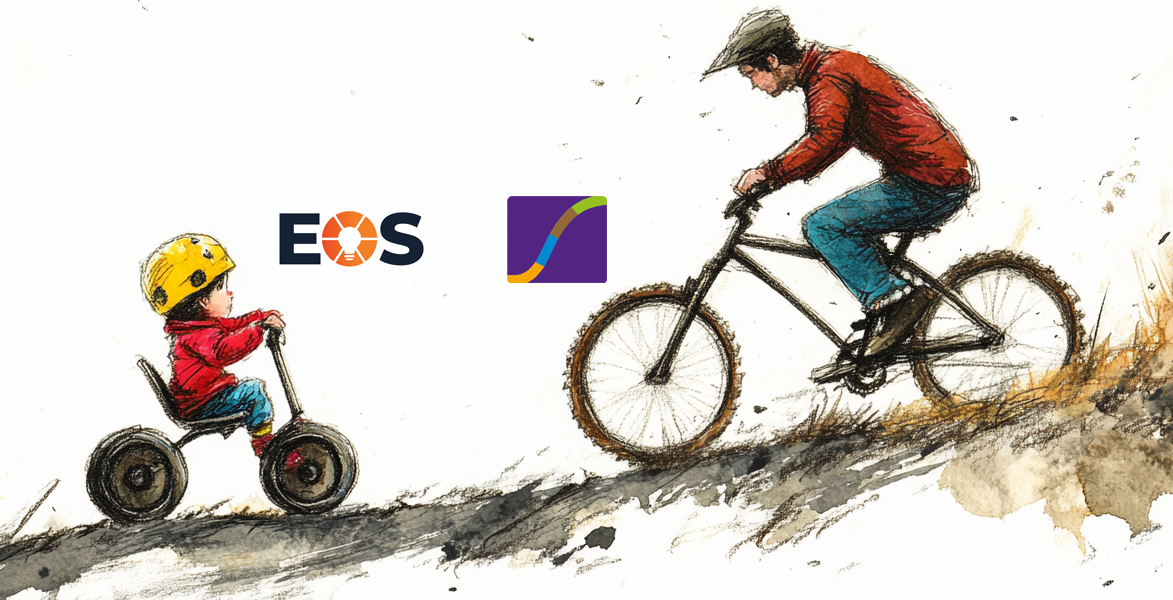Running a business is hard enough without using a framework that limits your growth. Imagine tackling a mountain trail on a tricycle. EOS Traction™ is that tricycle, great for businesses just starting out, offering stability and clarity when the path is pressed gravel, but for companies with big ambitions, it can become a hindrance. If you're scaling up and still riding EOS, you're limiting your potential. Scaling Up™, on the other hand, is the mountain bike built for growth, adapting to the rocky, unpredictable path your business is on.
The Limitations of EOS's Simplicity
EOS Traction's simplicity is its strength for small businesses with less than 15 employees. You get quick wins, clear roles, and a basic framework to execute short-term goals. But as your business grows, that simplicity can become a straightjacket. It's reliance on a rigid, one-size-fits-all approach becomes an Achilles' heel for scaling companies. Growing businesses need more than just accountability; they need flexibility, adaptability, and the ability to make nearly real-time strategic decisions. That's where Scaling Up excels.
Escape Rigidity
One of the most significant issues with EOS is its insistence on following a strict, methodical system known as "EOS Pure™." While this works well for templated implementation and getting the basics down, it can stifle growth as the company expands, which creates a dilemma; break the EOS rules or stay confined to a structure that no longer fits.
Scaling Up, by contrast, acts as more of an "open-source" toolset, meeting businesses where they are at. It provides a framework that adapts to your needs, allowing customization while still aligning with long-term goals. The One-Page Strategic Plan (OPSP) in Scaling Up exemplifies this flexibility. Unlike EOS's Vision/Traction Organizer (V/TO), the OPSP evolves with your business, helping you align not just on execution but on broader strategic and financial goals crucial for sustainable growth.
Scaling Up's Strategic Edge
While EOS focuses primarily on execution and people management, Scaling Up recognizes that business success requires a more comprehensive approach. It's not just about getting things done; it's about getting the RIGHT things done, in the RIGHT way, with the RIGHT people. The aim is effectiveness, not just efficiency.
The Rockefeller Habits Checklist, a cornerstone of Scaling Up, ensures you're aligning your entire team around strategic goals that matter most. You're building a business geared for long-term success, measuring not just outputs, but outcomes.
Transitioning
The good news is that transitioning from EOS to Scaling Up isn't starting from scratch. EOS was inspired by the work of Verne Harnish, the creator of Scaling Up. Therefore, many principles you've learned in EOS, such as people management, accountability, and clear processes, are drawn from Scaling Up's framework and have their corollary.
Here's how to make the transition smooth:
1. Start with the One-Page Strategic Plan (OPSP). This will help you see the bigger picture that EOS might have been missing. If you have the EOS V/TO™ use it to match directly to the OPSP.
2. Implement the Rockefeller Habits Checklist. This builds on the discipline you developed with EOS but adds a strategic layer. It will highlight the gaps in growth and help prioritize your next steps.
3. Focus on the four key areas of Scaling Up: People, Strategy, Execution, and Cash. This expands on EOS's vision by adding crucial elements like financial strategy.
4. Gradually introduce more complex Scaling Up tools as your team becomes comfortable with the new framework.
5. Retain applicable EOS practices like regular meeting rhythms, but expand their scope to include more strategic discussions.
Success Stories
"We were running EOS for three years, and while it got us some initial wins, we started feeling like we were spinning our wheels. Transitioning to Scaling Up was the best decision we made. The tools are more comprehensive, and the focus on cash and strategy allowed us to scale in ways EOS never could." – Founder of a $36M manufacturing company.
"EOS was great for building discipline in our team, but when we hit $13M in revenue, we needed a deep strategy. Scaling Up gave us a framework that aligned our entire organization." – CEO of a $13M services firm.
Blending Both Worlds
Despite my bias, EOS isn't without merit. In fact, there are a few tactics from EOS that I've found valuable enough to incorporate into my Scaling Up practice. The use of meeting timers to keep discussions focused, the discipline of sticking to an agenda, and the GWC™ (Get it, Want it, Capacity to do it) concept for team alignment are all useful tools that can enhance the Scaling Up framework.
However, these cherry-picked elements aside, the bulk of EOS is left behind when transitioning to Scaling Up. Scaling Up provides a comprehensive toolkit for businesses serious about long-term, sustainable growth to guide the challenges of genuinely scaling a business.
So, are you still riding a tricycle while trying to scale a mountain? If you're ready to stop spinning your wheels and start scaling for real, it's time to upgrade to Scaling Up.


